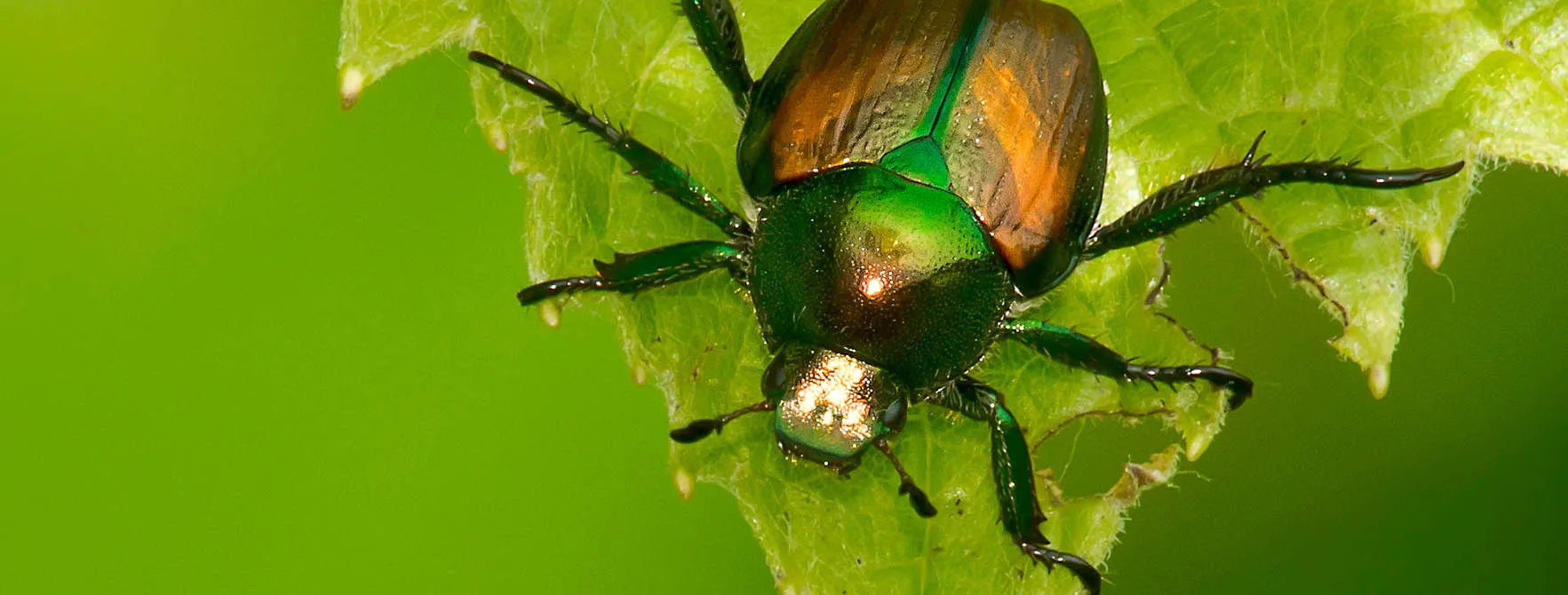
.jpg)
Japanese beetles (Popillia japonica) are highly destructive, invasive insects that pose a serious threat to a wide variety of trees, shrubs, and plants across Missouri. Recognizable by their metallic green bodies and copper-colored wing covers, adult beetles may look small and harmless at first glance, but their feeding habits can quickly turn beautiful trees into skeletonized shells of their former selves.
Originally from Japan, these beetles were first detected in the United States in the early 1900s and have since spread across much of the eastern and midwestern U.S. In Missouri, especially in the St. Louis region, Japanese beetles are a seasonal nuisance that appear in large numbers from late spring through mid-summer.
While the adults feed voraciously on leaves, flowers, and fruit, their larvae, known as white grubs, live underground and feed on grassroots, causing damage to lawns and weakening trees from below. Together, the adult and larval stages make Japanese beetles one of the most difficult tree pests to control once they become established.
In Missouri, Japanese beetles typically begin to emerge in early to mid-June, with peak activity occurring throughout July and early August. Their appearance is closely tied to soil temperatures—when the soil reaches about 60°F at a depth of 2 inches, the beetles begin to surface from their pupal stage underground.
Once they emerge, adult beetles are active for about 4 to 6 weeks, feeding aggressively on the foliage, flowers, and fruit of over 300 plant species. During this time, they also mate and lay eggs in nearby soil. The larvae (grubs) hatch a few weeks later and begin feeding on grassroots through the fall before going dormant for winter.
Key timing facts:
Winter: Grubs overwinter in the soil and resume feeding in spring
Japanese beetles are fairly easy to identify once you know what to look for. Their distinctive appearance and group-feeding habits make them stand out during the summer months.
Adult Japanese beetles:
Larvae (white grubs):
Japanese beetles cause visible and often widespread damage, particularly during peak feeding in mid-summer. Look for the following signs:
Japanese beetles may seem slow and easy to catch, but their life cycle and behavior make them surprisingly effective at expanding across neighborhoods and landscapes. Here’s how they typically spread from tree to tree and yard to yard:
Dealing with Japanese beetles requires a multi-pronged approach, especially during peak summer months when they feed most aggressively. Whether you’re looking to protect a single ornamental tree or safeguard an entire landscape, these treatment and prevention methods can help reduce beetle populations and minimize long-term damage.
Manual Removal (Early Infestation)
Hand-picking beetles and dropping them into soapy water is a safe and effective way to manage small infestations. This method works best early in the day when beetles are slower and easier to collect.
Insecticidal Sprays
Sprays containing carbaryl, bifenthrin, cyfluthrin, or permethrin can offer quick knockdown of beetles during peak activity. Apply during late June through July and reapply every 7 to 14 days as needed, while avoiding pollinators by spraying early or late in the day.
Systemic Insecticides (Preventive)
Applying systemic treatments like imidacloprid or acephate to the soil or trunk in late spring helps protect trees from the inside out. These insecticides are absorbed by the tree, making its leaves toxic to feeding beetles.
Avoid Attractant Traps
Although widely available, these traps often attract more beetles than they catch. If you use one, place it far away from valuable trees or garden beds to avoid making the problem worse.
Protective Netting (for Small Trees)
Fine mesh netting can physically shield young or ornamental trees during peak beetle activity. It’s a highly effective chemical-free option that completely blocks feeding.
Grub Control (for Lawn Management)
Since adult beetles emerge from grubs living in your soil, applying grub control products in late summer can reduce next year’s population. This works especially well when combined with above-ground treatments.
Encourage Natural Predators
Supporting birds, parasitic wasps, and beneficial insects in your landscape can help keep beetle populations in check. While not a complete solution, this provides helpful long-term biological control.
IIf you suspect Japanese beetles are damaging your trees or want to prevent an infestation before it starts, working with a certified local arborist is one of the smartest steps you can take.
At Ballwin Tree Service, our ISA Certified Arborists understand how to identify beetle activity early, apply targeted treatments safely, and develop a long-term prevention strategy tailored to your landscape. Don’t wait until the damage becomes irreversible, schedule your free tree health inspection today and let us help protect your property from these persistent pests.
.jpg)
